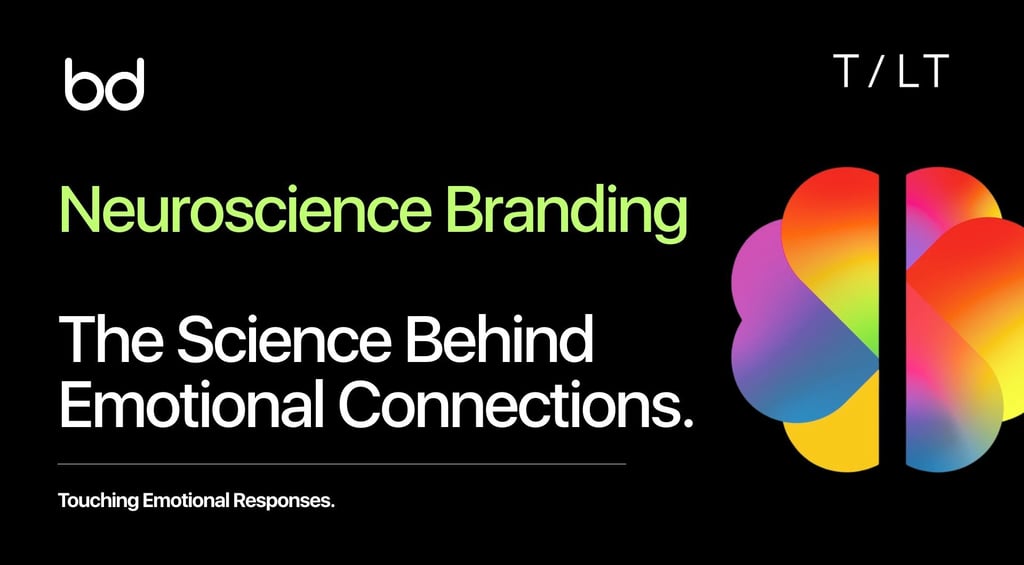Neuroscience of Branding: The Science Behind Emotional Connections
Dive with us into the science and theory of neurobranding to reveal how brand loyalty is built in the brain, not on the shelf.
Brand Blinks Global
4 min read


What truly sets unforgettable brands apart? The answer doesn’t lie in flashy logos or clever taglines alone but in the emotional connection woven deep into consumers’ minds. Dive with us into the science and theory of neurobranding to reveal how brand loyalty is built in the brain, not on the shelf.

The Brain: Where Your Brand Lives
At its core, a brand is not simply a company’s asset, a living, evolving network of associations inside each consumer’s mind. Legendary adman Walter Landor put it best: “Products are made in the factory, but brands are made in the mind.” Neuroscientifically, the brand exists as a complex web of semantic and emotional associations, distinctive for each person, yet shaped by shared cultural signals. neuroscience


Three Neuroscientific Laws of Branding
Distinctive Relevance: Brands that stand apart in memory (think Apple’s innovation or Nike’s athleticism) activate unique connections in the brain.
Coherence: Consistency in experiences and messaging ensures brands become “familiar friends,” strengthening neural pathways and recall.
Participation: True emotional resonance happens when consumers aren’t passive; they participate by engaging, sharing, and even co-creating their own stories with the brand.
If you want your brand to “live rent-free” in customers’ minds, start with a unique identity that makes people care and then deliver it reliably at every touchpoint.


Why Emotions Trump Logic (and the Science Behind It)
Modern neuroscience reveals that emotions are the shortcut to our decisions. Studies using fMRI and other brain imaging show that emotionally charged experiences light up brain regions linked to pleasure, reward, and long-term memory. Dopamine and oxytocin, chemical messengers released by emotions, are why joyful ads, heartfelt stories, or even controversy can create unforgettable branding moments.
In fact, research shows that up to 70% of customer decisions are based on subjective emotions and rational analysis. People with damaged emotional centers of the brain struggle with even basic decision-making, underscoring the critical role feelings play in consumer choice.
Foundations of Emotional Branding
Marc Gobé’s Emotional Branding Theory demonstrates that genuine emotional engagement is built on three pillars:
Authenticity: Trust and credibility spark the first neural connection.
Urgency & Belonging: Community and “being part of something” cement emotional loyalty.
Storytelling: Narrative links brand values to personal aspirations and identity.
Storytelling doesn’t just capture attention; it activates the brain’s narrative processing apparatus, embedding brands more deeply in memory.
Sensory Science: More Than What Meets the Eye
Brands aren’t just visual. Neuroscience shows that touch, taste, sound, and even scent can trigger strong emotional associations. McDonald’s signature smell, Toblerone’s iconic shape, or unique audio cues become “signature imprints” in the consumer psyche.
A brand’s strength is sealed at first purchase and reinforced every time a customer interacts, shares, comments, or advocates. The more active a consumer’s engagement, the stronger and more diverse their associative neural network becomes.
Encouraging two-way interactions, community Q&As, user-generated content, or comment threads harnesses the law of participation, strengthening emotional bonds and transforming one-time buyers into brand loyalists.
Actionable Tips for Applying Neuroscience to Your Brand
Focus your brand identity on a “meaning core,” the one emotion or value the brand should always evoke.
Map out a consistent sensory experience (visuals, sound, touch) across every channel.
Tell stories that align with your audience’s aspirations and self-image.
Foster interactive spaces, comments, discussions, and UGC to deepen participation and recall.
Takeaway: The Future Is Human. And Neural.
Branding isn’t just about what’s sold, it’s about what’s felt. By anchoring every element to the science of emotion and theories of neurobranding, today’s marketers can craft experiences that last long after the campaign ends.
Want to put neurobranding to work for your business? Let’s co-create a brand that lives in hearts and brains.
Next Steps?
Check out our Branding Strategy, Content Marketing, and Community Engagement services to leverage actionable neuroscience insights.
Leave a comment: What brand made the biggest emotional impression on you and why?
Share this newsletter for science-backed branding tips in your network.
Tags
Neuromarketing, Brand Neuroscience, Emotional Branding, Neurobranding Theory, Customer Loyalty, Sensory Branding, Brand Storytelling, Brand Engagement, Consumer Psychology, Limbic Branding, Brand Memory






© 2025 BRNDXMORPH Media Worldwide Private Limited. All rights reserved
Brand Blinks Global® | BBG is an independent global brand consulting and transformation company.
The trademarks, logos, and service marks displayed on this site are the property of their respective owners.
"Brand Blinks Global®," "Brand Blinks®," "Made for the Uncommon®," and the "bd®" logo are trademarks or registered trademarks of BRNDXMORPH Media Worldwide Private Limited.
RESOURCES
INTELLIGENCE
BUSINESS
PARTNER
COVERAGE
EXPLORE
Made for the Uncommon®


When your brand grows, others rise too. 2% of your project empowers a nonprofit we back together every year.


